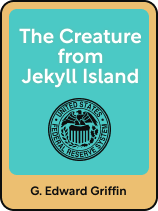

This article is an excerpt from the Shortform book guide to "The Creature from Jekyll Island" by G. Edward Griffin. Shortform has the world's best summaries and analyses of books you should be reading.
Like this article? Sign up for a free trial here.
How does the Federal Reserve affect the economy? Does it help or harm?
Helping to stabilize the economy is allegedly a key part of the Fed’s mission, but Edward Griffin argues that, in fact, it tends to destabilize the economy. It does this in two ways: amplifying normal business cycles and protecting banks from bad investments.
Continue reading to learn about the Fed’s negative impacts on the economy.
Harm #1: Amplifying Business Cycles
How does the Federal Reserve affect the economy? First, Griffin asserts that, by facilitating fractional lending, the Fed amplifies normal cycles of economic growth and contraction, thereby creating economic instability. He argues that, if there were no fractional lending and the money supply was fixed, there would still be fluctuations in the economy but that these business cycles would be much less pronounced than what we see today.
As we’ve discussed, fractional lending creates money out of thin air by loaning out the same money that a bank must keep available for withdrawal. When banks iteratively receive deposits and lend them out, the money gets repeatedly double-counted, so the total amount of money in circulation grows exponentially as long as banks are making loans.
Thus, as Griffin explains, when the economy is growing and businesses are borrowing money to finance new start-ups, the money supply grows rapidly. All the additional money in the economy creates a temporary boom. But, as the supply of money increases, its purchasing power diminishes, and prices rise. As prices rise, some businesses are unable to complete their expansion projects or start-ups. As these ventures fail, the economy begins to contract.
Businesses stop borrowing and start trying to cut expenses. Some repay their loans, others default on them, and the same process that caused the money supply to expand now works in reverse, causing it to decrease exponentially. With money in short supply, the economy goes into recession. This is how fractional lending causes boom-and-bust cycles in the economy.
| Austrian Business Cycle Theory Griffin did not originate the idea that fluctuations in the money supply destabilize the economy by amplifying business cycles—this concept is central to Austrian Business Cycle Theory, which is a key component of the Austrian School of economic thought. The Austrian School offers some additional perspective on the subject, as well as some additional criticism of central banks such as the Federal Reserve. The Austrian School asserts that central banks destabilize the economy not only through fractional lending but also by artificially lowering interest rates. The Fed (and other central banks) loan money to banks at a “discount window” or “discount rate,” increasing the availability of capital and driving down interest rates throughout the economy. Fractional lending, then, amplifies this effect by further increasing the money supply as loans are taken out at rates that are lower than they’d be if subject to natural economic pressures. According to Austrian economic theory, interest rates reflect the value of money plus time, and allow business people to assess whether a project is worth taking on: Will a business venture return more profit than interest rates would, given time? But interest rates that the Fed sets lower than they would be based on market forces lead to inaccurate projections, which lead to failed business ventures. As these failed ventures accumulate, they trigger a contraction of the money supply as they are liquidated to pay off their loans or default on them outright. These small contractions are amplified by fractional lending, leading to ever-larger economic contraction and triggering an economic recession. Thus, according to Austrian economic theory, the Fed introduces microeconomic instability by artificially depressing interest rates, and fractional lending (which, as Griffin points out, the Fed facilitates) amplifies the effect, resulting in macroeconomic instability. (Note: Despite the name, the Austrian School is not geographically confined to Austria—it merely originated there. It is the third most common economic perspective in the United States after Keynesianism and Monetarism.) |
Harm #2: Protecting Banks From Bad Investments
The second way that the Fed destabilizes the economy, according to Griffin, is by sheltering banks from the consequences of poor business decisions, thereby incentivizing them to engage in risky business practices. He discusses three mechanisms that remove banks’ incentive to operate responsibly.
Mechanism 1: Lender of Last Resort. One of the Fed’s original core functions was to act as a benevolent “lender of last resort,” allowing banks to borrow practically unlimited funds in case of a liquidity emergency (a situation where the bank doesn’t have enough cash or other “liquid assets” to operate). By performing this function, the Fed insulates banks from risk by ensuring that they can always borrow enough funds to meet their immediate obligations. This incentivizes practices like fractional lending, where the bank would be obliged to pay out more money than they have if all their depositors withdrew their money at the same time.
Mechanism 2: Bailouts. When a large enough bank gets into financial trouble, the government typically steps in to prevent it from failing, ultimately transferring the bank’s losses to American taxpayers. But, perhaps more importantly, the government also bails out large corporations and foreign governments that borrow from banks in the US. As such, if the borrower is big enough to be eligible for a bailout, then the bank doesn’t need to consider the soundness of the borrower’s business practices. The availability of large loans to fund risky or wasteful business ventures leads to large failed business ventures, which contribute to economic instability.
This is because the loan carries no risk for the bank since even if the borrower defaults, someone (usually American taxpayers) will still pay back the loan with interest. Griffin concedes that, in bailout situations, banks often take a token loss, but he argues that the amount banks write off in such cases isn’t large enough to make a dent in their profit from the loan. He also notes that, while Congress is responsible for most bailouts, the Fed facilitates the process.
Mechanism 3: Deposit Insurance. Through the Federal Deposit Insurance Corporation (FDIC), the Fed insures all bank deposits, so depositors have little reason to vet the credibility of their banks and banks don’t have to compete with each other for depositors’ trust by adhering to sound business practices.
Griffin thinks that, if the FDIC were abolished, private insurance companies would begin offering deposit insurance to banks. He expects these companies would scrutinize each bank’s business practices and adjust their premiums based on the risk that each bank posed. This would incentivize banks to avoid risky practices (fractional lending, for example), in contrast to the FDIC’s flat rates, which provide no incentive for banks to handle their depositors’ money responsibly.
| How Much Does the Fed Really Protect Banks From Risk? Some economists argue that banks aren’t sheltered from risk as much as Griffin says because the picture that he paints of how the FDIC and the Fed operate is incomplete. In the case of the Fed acting as a lender of last resort, most economists acknowledge that this function does involve a moral hazard (a financial incentive to take risks because you’re sheltered from the consequences), but they argue that not having a lender of last resort would present an even greater hazard overall. Without a lender of last resort, banks facing liquidity crises would fail. Bank failures disrupt the business of the bank’s depositors, which, in turn, disrupts the economy. Thus, the economic instability introduced by bank failures is arguably greater than the economic instability introduced by the moral hazard of having a lender of last resort for banks to fall back on. In the case of bailouts, generally, the government bails out only businesses whose failure would cause a systemic collapse of the US economy. A bank can’t know in advance whether the government would bail it out during a crisis. For example, in the 2008 housing market crash, the government bailed out several large financial institutions, but it let Merrill Lynch fail and be bought up by Bank of America. Thus, banks are unlikely to base their business decisions on the chance of a bailout. It’s also worth noting that, in the case of the 2008 bailouts, the US Treasury reports that in the end, the financial institutions it bailed out not only survived but eventually repaid the money they received with interest, so the bailout ended up being a good investment of taxpayers’ money. This tends to imply that, while these companies unquestionably made some poor business decisions leading to the crash, at least they learned from their mistakes and went on to become profitable again. Furthermore, with the passage of the Dodd-Frank Act in 2010, the government seems to be trying to get out of the bailout business. The Dodd-Frank Act endeavors to replace bailouts with “bail-ins.” In a bail-in, a financial institution that gets into financial trouble but whose failure would jeopardize the economy at large is allowed to cannibalize its depositors’ “unsecured assets.” (Unsecured assets are those not protected by the FDIC, such as deposits in excess of the threshold that the FDIC insures.) Basically, a bail-in enables a financial institution to avoid a complete failure without the injection of outside capital by passing on some of its losses to its depositors. As such, bail-ins highlight the limitations of FDIC deposit insurance, and imply that banks do have to compete for the trust of their depositors since their depositors are at risk of losing money if the bank has to execute a bail-in. This is especially important for large depositors, whose balances are more likely to exceed FDIC thresholds. |

———End of Preview———
Like what you just read? Read the rest of the world's best book summary and analysis of G. Edward Griffin's "The Creature from Jekyll Island" at Shortform.
Here's what you'll find in our full The Creature from Jekyll Island summary:
- How the Federal Reserve System destabilizes the economy
- Why banks are encouraged to engage in fraudulent practices that harm the public
- How the Federal Reserve can be abolished






